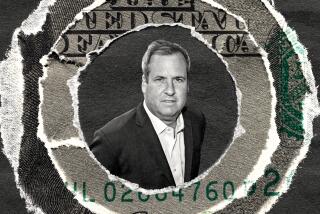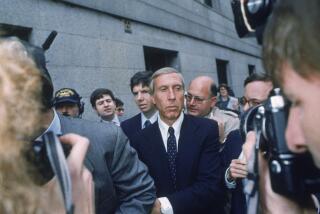Forgettable Moments of Investing During 1990
- Share via
Right for the Wrong Reason--Michael Murphy, editor of the San Francisco-based Overpriced Stock Service newsletter, is one of Wall Street’s best-known short sellers--those traders who sell stock they don’t own, betting that prices are going lower.
The June issue of OSS carried a headlined with the none-too-subtle message SHORT EVERYTHING!, in letters almost large enough to be read by passing planes.
It was a good call, of course: The stock market peaked in mid-July, then plunged in August with the Iraqi invasion of Kuwait. Murphy didn’t have a private line to Saddam, however. Instead, the veteran short seller believed that the Federal Reserve would be unable to lower interest rates in 1990--so Murphy saw little reason to own stocks in an iffy economy.
You were dead wrong on rates, Mike. But just ask his happy bear subscribers if they’re complaining.
Clan of the Unemployed Cave Bear--Here’s a brokerage management aptitude test: It’s late in 1990, and deep into the bear market. You employ two very quotable, very well known market strategists. One has been bearish all year, correctly predicting trouble in the financial system. The other has been mostly bullish. When layoff time comes in November, which one do you fire?
Oppenheimer & Co. dumped its bear, Suresh Bhirud, and kept its bull, Michael Metz.
In the securities business, hope springs eternal.
We Liked Teledyne ‘Classic’ Better--Teledyne Inc. Chairman Henry Singleton figured he had a good idea in February: Split his conglomerate in two, leaving Teledyne’s manufacturing businesses in one company and the insurance business in another. The market would understand the two operations much more clearly, and the sum of the two stocks would probably be worth more than the original whole. Hey, it worked in the ‘80s, didn’t it?
Singleton, 73, is no newcomer to finance, and he ranks as one of the great company builders of all time. But maybe he should have left well enough alone. The old Teledyne traded for $72 a share. New Teledyne trades for $16 a share, and the spun-off insurance company, Unitrin, for $33 a share. So the sum of the parts is $46.
True, manufacturing has had a bad year. But at least in the old, confusing, unfocused, classic Teledyne, manufacturing had insurance to hide behind.
Maybe They Should Call It the Misery Index--When San Francisco-based money manager Associated Capital launched its California 300 stock index last spring, the idea was to spotlight the success of California stocks, from Arco to Zero Corp.
Some success. If we had looked backward, we would have founding the index of 300 major California stocks lagging the broad market every year since 1985. And this year was another bummer for Golden State stocks: The California 300’s total return (including dividends) was a loss of about 9%, versus a drop of about 3% for the Standard & Poor’s 500 index.
Blame S&L; and real-estate related stocks for the latest slump. In the late ‘80s, the index was dragged down by the awful performance of the state’s high-tech and energy stocks.
What about 1991? Look at it this way: After six years of lagging the S&P; 500, it’s either really time to hunt for bargains among California stocks, or you may as well just bag it and buy the Oregon 30 or the Utah 12 instead.
Can You Spell I-K-E-A--An old Wall Street line is that stocks are sold, not bought. Investment bankers Robertson, Stephens & Co. and Bateman Eichler, Hill Richards did one magnificent selling job with home furnishings retailer Stor Furnishings International last April.
The two firms managed to persuade their investors to plunk down $8 apiece for 2.25 million shares of Stor in its initial public stock offering. Today, the stock sells for $1.75 a share, a tidy 80% plunge in eight months.
In retrospect, City of Industry-based Stor was a capital loss waiting to happen. The firm operated only three stores, all in Los Angeles. Its costly expansion plans almost guaranteed that there would be no earnings for the foreseeable future. And in the meantime, competitor Ikea, the Swedish-based global behemoth in the retail home-furnishings business, was planning to plow into the L.A. market.
So why, you ask, would anyone buy Stor stock--or at the very least, why would they pay $8 a share for the initial offering, when the odds were overwhelming that you could pick up the shares later for less?
How do you say suckered in Swedish?
Here, Catch This Javelin--Olympic organizing legend Peter V. Ueberroth and partners bought a controlling stake in hemorrhaging Hawaiian Airlines in December, 1989, for $22 a share. Some people thought Ueberroth overpaid, considering long-troubled Hawaiian hadn’t been profitable since 1986. But Security Pacific Bank still agreed to ante up multimillions in financing for the deal.
From there, the math got a little more icky. Hawaiian lost $26.06 a share in the first nine months of 1990. A profit still isn’t in sight. Hawaiian stock now is at $9 a share, and to some analysts, it isn’t worth half that.
Yet, incredibly, Ueberroth et al. earlier this month managed to persuade debt-laden Northwest Airlines to fork over $20 million for a 25% stake in Hawaiian.
Northwest gets a coveted Australian route out of the deal. Still, the history of Hawaiian--this is a stock that sold for $48 a share in 1987--suggests that your grandmother was on to something when she told you not to throw good money after bad.
Don’t Do as I Say, and Definitely Don’t Do as I Do--As California bank and S&L; stocks continued their free fall all year long, some big investors were sure that the market was missing something. So this select group--including many bank and S&L; officers--jumped into the stocks in a major way.
These people are financial experts?
In July and August, for example, seven CalFed Inc. officers and directors bought the S&L;’s shares on the open market for prices ranging between $9 and $10.50. Unfortunately, since then, the market has had a “66% off” sale on CalFed stock. It sells for about $3 today.
Northern California hotelier Ted Krutschnitt paid between $5 and $7.50 a share for his initial 976,400 shares of Coast Savings in May, June and July. Should have waited, Ted: You could have it now for $2 a share.
The list goes on and on. Will these investors make money over the long term? Maybe. But they also may have forgotten one of Wall Street’s cardinal rules: It’s almost always better to buy late and sell early than vice-versa. Hollywood loves heroes, but the stock market usually eats them for lunch.
More to Read
Inside the business of entertainment
The Wide Shot brings you news, analysis and insights on everything from streaming wars to production — and what it all means for the future.
You may occasionally receive promotional content from the Los Angeles Times.










